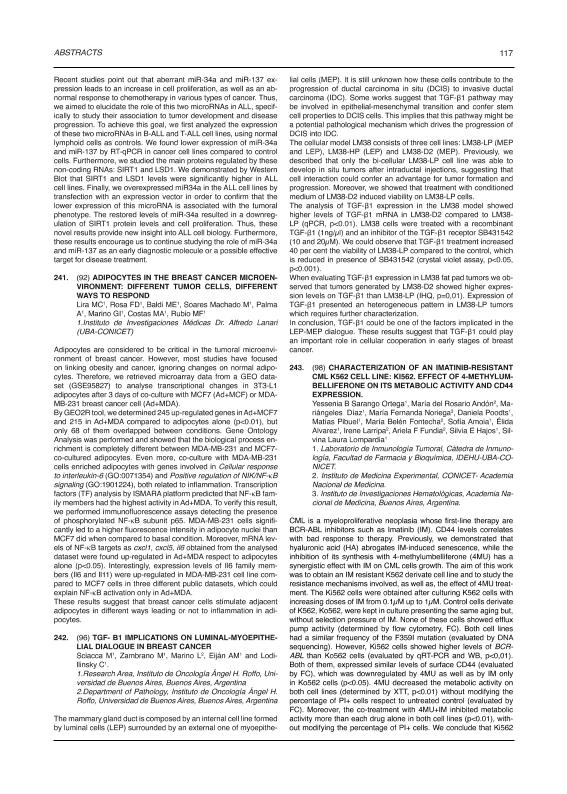Evento
Characterization of an Imatinib-resistant CML K562 cell line: Ki562: Effect of 4-methylumbelliferone on its metabolic activity and CD44 expression
Sarango Ortega, Yesennia B.; Anadon, María del Rosario ; Díaz, Mariángeles
; Díaz, Mariángeles ; Noriega, Maria Fernanda; Poodts, Daniela; Pibuel, Matías Arturo
; Noriega, Maria Fernanda; Poodts, Daniela; Pibuel, Matías Arturo ; Fontecha, María Belén; Amoia, Sofía; Alvarez, Elida Ester; Larripa, Irene Beatriz
; Fontecha, María Belén; Amoia, Sofía; Alvarez, Elida Ester; Larripa, Irene Beatriz ; Fundia, Ariela F.; Hajos, Silvia Elvira
; Fundia, Ariela F.; Hajos, Silvia Elvira ; Lompardía, Silvina Laura
; Lompardía, Silvina Laura
 ; Díaz, Mariángeles
; Díaz, Mariángeles ; Noriega, Maria Fernanda; Poodts, Daniela; Pibuel, Matías Arturo
; Noriega, Maria Fernanda; Poodts, Daniela; Pibuel, Matías Arturo ; Fontecha, María Belén; Amoia, Sofía; Alvarez, Elida Ester; Larripa, Irene Beatriz
; Fontecha, María Belén; Amoia, Sofía; Alvarez, Elida Ester; Larripa, Irene Beatriz ; Fundia, Ariela F.; Hajos, Silvia Elvira
; Fundia, Ariela F.; Hajos, Silvia Elvira ; Lompardía, Silvina Laura
; Lompardía, Silvina Laura
Tipo del evento:
Reunión
Nombre del evento:
LXV Reunión Anual de la Sociedad Argentina de Investigación Clínica; LXVIII Reunión anual de la Sociedad Argentina de Inmunología y Reunión anual de la Sociedad Argentina de Fisiología
Fecha del evento:
10/11/2020
Institución Organizadora:
Sociedad Argentina de Investigación Clínica;
Sociedad Argentina de Inmunología;
Sociedad Argentina de Fisiología;
Título de la revista:
Medicina (Buenos Aires)
Editorial:
Fundación Revista Medicina
Idioma:
Inglés
Clasificación temática:
Resumen
CML is a myeloproliferative neoplasia whose first-line therapy are BCR-ABL inhibitors such as Imatinib (IM). CD44 levels correlates with bad response to therapy. Previously, we demonstrated that hyaluronic acid (HA) abrogates IM-induced senescence, while the inhibition of its synthesis with 4-methylumbelliferone (4MU) has a synergistic effect with IM on CML cells growth. The aim of this work was to obtain an IM resistant K562 derivate cell line and to study the resistance mechanisms involved, as well as, the effect of 4MU treatment. The Ki562 cells were obtained after culturing K562 cells with increasing doses of IM from 0.1µM up to 1µM. Control cells derivate of K562, Ko562, were kept in culture presenting the same aging but, without selection pressure of IM. None of these cells showed efflux pump activity (determined by flow cytometry, FC). Both cell lines had a similar frequency of the F359I mutation (evaluated by DNA sequencing). However, Ki562 cells showed higher levels of BCR-ABL than Ko562 cells (evaluated by RT-PCR and WB, p<0,01). Both of them, expressed similar levels of surface CD44 (evaluated by FC), which was downregulated by 4MU as well as by IM only in Ko562 cells (p<0.05). 4MU decreased the metabolic activity on both cell lines (determined by XTT, p<0.01) without modifying the percentage of PI+ cells respect to untreated control (evaluated by FC). Moreover, the co-treatment with 4MU+IM inhibited metabolic activity more than each drug alone in both cell lines (p<0.01), without modifying the percentage of PI+ cells. We conclude that Ki562 cells would be an interesting model to study IM resistance since the overexpression of BCR-ABL is one of the mechanisms related to therapeutic failure in CML patients. The loss of CD44 modulation in Ki562 cells could also be involved in their resistance. In addition, 4MU shows a cytostatic effect and enhances IM effect on metabolic activity, supporting the hypothesis of 4MU as a promising therapeutic strategy in CML.
Palabras clave:
LMC
,
4-METHYLUMBELLIFERONE
,
HYALURONAN
,
IMATINIB
Archivos asociados
Licencia
Identificadores
Colecciones
Eventos(IBYME)
Eventos de INST.DE BIOLOGIA Y MEDICINA EXPERIMENTAL (I)
Eventos de INST.DE BIOLOGIA Y MEDICINA EXPERIMENTAL (I)
Eventos(IDEHU)
Eventos de INST.DE EST.DE LA INMUNIDAD HUMORAL PROF.R.A.MARGNI
Eventos de INST.DE EST.DE LA INMUNIDAD HUMORAL PROF.R.A.MARGNI
Citación
Characterization of an Imatinib-resistant CML K562 cell line: Ki562: Effect of 4-methylumbelliferone on its metabolic activity and CD44 expression; LXV Reunión Anual de la Sociedad Argentina de Investigación Clínica; LXVIII Reunión anual de la Sociedad Argentina de Inmunología y Reunión anual de la Sociedad Argentina de Fisiología; Argentina; 2020; 1-1
Compartir



